
Tyrannosaurus is a genus of large theropod dinosaur. The species Tyrannosaurus rex, often called T. rex or colloquially T-Rex, is one of the best represented theropods. Tyrannosaurus lived throughout what is now western North America, on what was then an island continent known as Laramidia. Tyrannosaurus had a much wider range than other tyrannosaurids. Fossils are found in a variety of rock formations dating to the Maastrichtian age of the Upper Cretaceous period, 68 to 66 million years ago. It was the last known member of the tyrannosaurids and among the last non-avian dinosaurs to exist before the Cretaceous–Paleogene extinction event.

Predation is a biological interaction where one organism, the predator, kills and eats another organism, its prey. It is one of a family of common feeding behaviours that includes parasitism and micropredation and parasitoidism. It is distinct from scavenging on dead prey, though many predators also scavenge; it overlaps with herbivory, as seed predators and destructive frugivores are predators.

Orthoptera is an order of insects that comprises the grasshoppers, locusts, and crickets, including closely related insects, such as the bush crickets or katydids and wētā. The order is subdivided into two suborders: Caelifera – grasshoppers, locusts, and close relatives; and Ensifera – crickets and close relatives.

The common grasshopper warbler is a species of Old World warbler in the grass warbler genus Locustella. It breeds across much of temperate Europe and the western Palearctic. It is migratory, wintering in north and west Africa.

Parrotfishes are a group of about 90 fish species regarded as a family (Scaridae), or a subfamily (Scarinae) of the wrasses. With about 95 species, this group's largest species richness is in the Indo-Pacific. They are found in coral reefs, rocky coasts, and seagrass beds, and can play a significant role in bioerosion.
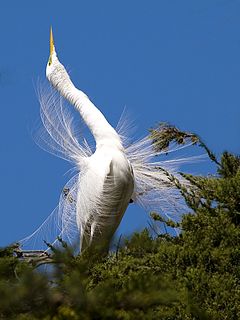
Animal communication is the transfer of information from one or a group of animals to one or more other animals that affects the current or future behavior of the receivers. Information may be sent intentionally, as in a courtship display, or unintentionally, as in the transfer of scent from predator to prey. Information may be transferred to an "audience" of several receivers. Animal communication is a rapidly growing area of study in disciplines including animal behavior, sociology, neurology and animal cognition. Many aspects of animal behavior, such as symbolic name use, emotional expression, learning and sexual behavior, are being understood in new ways.
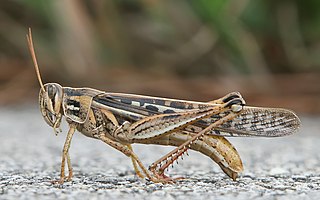
Grasshoppers are a group of insects belonging to the suborder Caelifera. They are among what is possibly the most ancient living group of chewing herbivorous insects, dating back to the early Triassic around 250 million years ago.

Anti-predator adaptations are mechanisms developed through evolution that assist prey organisms in their constant struggle against predators. Throughout the animal kingdom, adaptations have evolved for every stage of this struggle, namely by avoiding detection, warding off attack, fighting back, or escaping when caught.
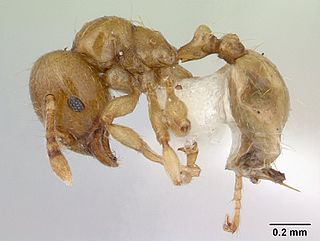
Allomerus decemarticulatus is an Amazonian ant species found in the tropics of South America. This species is most notable for the workers’ complex and extreme predatory behavior, which involves a symbiosis with both a plant and fungal species. They live in leaf pockets of a host plant species, Hirtella physophora. These leaf pockets are areas inside of the plant between the leaves and the stem. Each colony, which consists of about 1,200 workers, inhabits a single tree; however, the ants are spread among the leaf pockets, with typically 40 workers per pocket. Their diet primarily consists of large insects that are captured on the plant, but they also eat some kinds of food bodies produced by the plant as well as its nectar. They are able to capture their prey, which is much larger than themselves, by constructing a platform that acts as a trap for the unsuspecting prey. The ants hide in the trap and attack when any insect lands on it. This technique is an example of ambush predation.
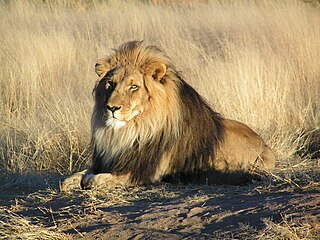
An apex predator, also known as a top predator, is a predator at the top of a food chain, without natural predators.

Azhdarchidae is a family of pterosaurs known primarily from the Late Cretaceous Period, though an isolated vertebra apparently from an azhdarchid is known from the Early Cretaceous as well. Azhdarchids included some of the largest known flying animals of all time, but smaller cat-size members have also been found. Originally considered a sub-family of Pteranodontidae, Nesov (1984) named the Azhdarchinae to include the pterosaurs Azhdarcho, Quetzalcoatlus, and Titanopteryx. They were among the last known surviving members of the pterosaurs, and were a rather successful group with a worldwide distribution. By the time of the end-Cretaceous mass extinction, most pterosaur families except for the Azhdarchidae disappear from the fossil record, but recent studies indicate a wealth of pterosaurian fauna, including pteranodontids, nyctosaurids, tapejarids and several indeterminate forms. In several analyses, some taxa such as Navajodactylus, Bakonydraco and Montanazhdarcho were moved from Azhdarchidae to other clades.

Aphaneramma is an extinct genus of marine temnospondyl amphibian. It lived during the Early Triassic epoch. Fossils have been found in the Mianwali Formation of Pakistan, Madagascar, the Zhitkov Formation of Russia, and the Kongressfjellet Formation of Svalbard (Norway).

Colomesus psittacus, the Banded puffer, parrot puffer or South American estuarine puffer, is a species of pufferfish found all along the Western Atlantic coastline of South America from the Gulf of Paria down to the mouth of the Amazon River in Brazil.

Confuciusornithidae is an extinct family of pygostylian avialans known from the Early Cretaceous, found in northern China. They are commonly placed as a sister group to Ornithothoraces, a group that contains all extant birds along with their closest extinct relatives. Confuciusornithidae contains four genera, possessing both shafted and non-shafted (downy) feathers. They are also noted for their distinctive pair of ribbon-like tail feathers of disputed function.

The northern grasshopper mouse is a North American carnivorous rodent of the family Cricetidae. It ranges over much of the western part of the continent, from southern Saskatchewan and central Washington to Tamaulipas in northeast Mexico.

Metarhizium acridum is the new name given to a group of fungal isolates that are known to be virulent and specific to the Acrididea (grasshoppers). Previously, this species has had variety status in Metarhizium anisopliae ; before that, reference had been made to M. flavoviride or Metarhizium sp. describing an "apparently homologous and distinctive group" of isolates that were most virulent against Schistocerca gregaria in early screening bioassays.

The Filozoa are a monophyletic grouping within the Opisthokonta. They include animals and their nearest unicellular relatives.

The grey parrot, also known as the Congo grey parrot, Congo African grey parrot or African grey parrot, is an Old World parrot in the family Psittacidae. The Timneh parrot (Psittacus timneh) once was identified as a subspecies of the grey parrot, but has since been elevated to a full species.

Advertising in biology means the use of displays by organisms such as animals and plants to signal their presence for some evolutionary reason.
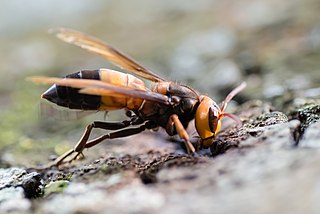
Vespa soror is a species of hornet present in India, Northern Thailand, Laos, Northern Vietnam, and parts of South China, including Hong Kong, Guangdong, Fujian, and Hainan Island.




















